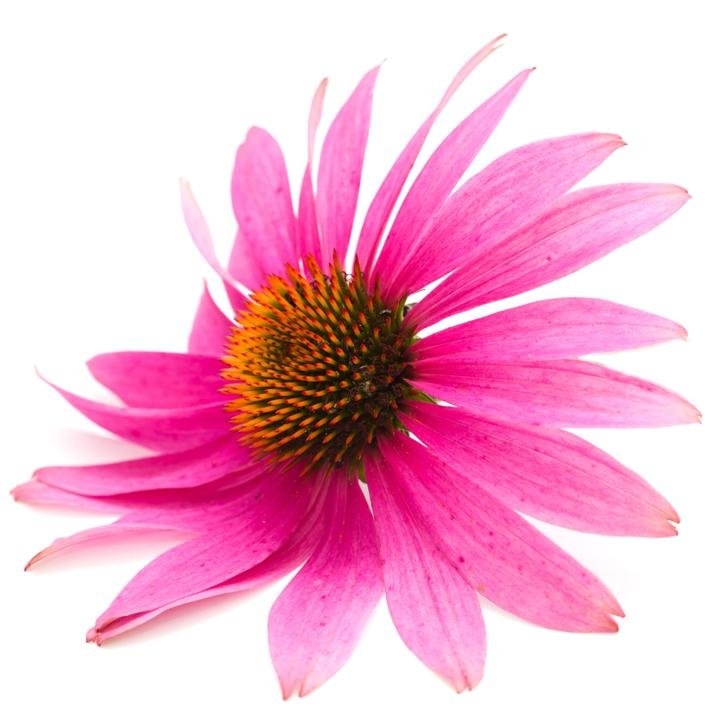Description
Perennial, strong plant, 50 cm high or more; it is fixed to the ground by a columnar root from which numerous rootlets come out. Fusiform, cylindrical or slightly sharp root, sometimes rolled in spiral form that passes imperceptibly to the rhizome in the upper part; rhizome diameter over 15 mm; roots diameter about 4-10 mm; outermost surface from pale brown to yellowish-brown; rhizomes are topped by parts of the aerial stem and some rings at the surface. Roots longitudinally wrinkled and deeply grooved with short fractions when dry but that turn hard and flexible when they get in contact with the atmosphere. The stem is thin and villose. Entire leaves are elongated, narrow, lanceolate, and villose. Terminal capitules with tubular light-yellow flowers. The outermost ones are ligulate and pink. Spinous bract of the cone is spotted in orange. It belongs to the Compositeae family (Asteraceae).
Native from North America limestone prairies. Its cultivated in sandy riversides and prairies. There are 9 different species of Echinacea, the most commonly used in medicine are Echinacea angustifolia, Echinacea pallida and Echinacea purpurea. These three species differ in the color of their flowers: E. angustifolia’s flowers are mauve, E. pallida has white flowers, and E. purpurea’s ones go from pink to purplish-red. They also differentiate from each other by their leaves. E. purpurea has serrated, lanceolate, oval-shaped leaves; on the other hand, the other two leaves are not lanceolate. According to some authors, E. purpurea is more active in the test tubes and E. angustifolia more effective in people. The whole plant is gathered when blooming, even though the most important part is the root.
Part used
Echinacea angustifolia: the root and rarely the entire plant.
Echinacea purpurea: aerial parts and sometimes the root.
Indications
Internal use
- Prophylaxis and treatment of infections of any etiology.
- Respiratory tract infections: common cold, flu, unproductive cough, tonsillitis, pharyngitis, laryngitis, otitis, rhinitis, sinusitis, bronchitis, etc.
- Urinary tract infections.
- Genital diseases: gonorrhea, syphilis, vaginal candidiasis, salpingitis, pelvic inflammatory disease.
- Gastrointestinal infections: diarrhea, colitis.
- Skin infections: furuncles, simple herpes, genital herpes, etc.
- Febrile conditions.
- Joint inflammations.
- Allergies (except if the allergies to any member of the daisy and sunflower family).
- Benign Prostatic Hyperplasia, chronic and acute prostatitis, vesiculitis. In this case, it is convenient to combine it with pygeum (Prunus africana).
- To reduce any side effects of antineoplastic therapy (irradiation, chemotherapy). The immunostimulant might become an alternative or at least an adjuvant to chemotherapy and might help to prevent infections and activate the immune system in people whose immune response is damaged.
- Aphrodisiac: Echinacea extract is used as an aphrodisiac in both, external and internal use, especially in men.
External use
- Skin disorders: hard to heal wounds, burns, furuncles, ulcers, post-surgery abscess, simple herpes, genital herpes, acne, dermatitis, psoriasis. According to some studies, echinacea extract applied on the skin is as effective as topical indomethacin, a strong anti-inflammatory drug.
- Dental and mouth infections: stomatitis, swollen gum, periodontitis, gingivitis.
- Insect bites.
- Aphrodisiac: Echinacea extract applied as an ointment on the glans penis favors the erection by nervous reflex stimulation and local vasodilation.
Bibliography
British Herbal Pharmacopoeia, 1990.
Plantas Medicinales. Thérapeutique-Toxicité. Christiane Vigneau. Masson, Paris 1985.
Herbal Drugs and Phytopharmaceuticals. Norman Grainger Bisset (Ed). Max Wichtl. CRC Press.1994.
Plantas Medicinales y Drogas Vegetales para infusión y tisana. Edición española a cargo de: Salvador Cañigueral, Roser Vila, Max Wichtl.1998.
Plantas Medicinales. Margarita Fernandez y Ana Nieto. Ed Universidad de Navarra. EUNSA 1982.
The Complete German Commission E Monographs. Therapeutic Guide To Herbal Medicines. Mark Blumenthal. American Botanical Council 1998.
Pharmacognosy, Phytochemistry, Medicinal Plants. Jean Bruneton. Lavoisier Publishing.
Fitoterapia. Vademecum de Prescripción. Plantas Medicinales. Editorial Masson. 4ª edición.
Fitoterapia Aplicada. J.B. Peris, G. Stübing, B.Vanaclocha. Colegio Oficial de Farmacéuticos de Valencia 1995.
Pharmacognosy 9th edition. Varro E. Tyler – Lynn R. Brady – James E. Robbers.
The Natural Pharmacy. Miriam Polunin and Christopher Robbins. 1992.
Guía de las Plantas Medicinales. Cuarta edición. Paul Schauenberg / Ferdinand Paris.
100 Plantes Medicinales. Max Rombi. Romart 1998.
Botanical Influrences on IIIness. Melvyn R. Werbach, M.D. Michael T. Murray, N.D.
El gran libro de las Plantas Medicinales. M.Pahlow.
Farmacognosia. Fitoquímica. Plantas medicinales. J. Bruneton. Editorial Acribia. 2ª edición.
Catálogo de Plantas Medicinales. Consejo General de Colegios Oficiales de Farmacéuticos. 2003.
